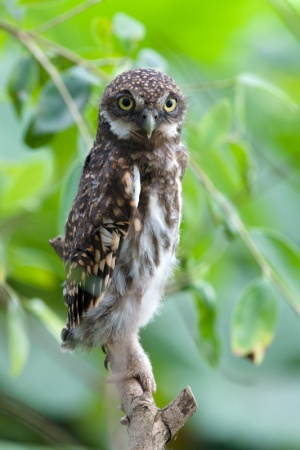
Photo © by Alok Tewari
Bhimtal, Alt. 4900 ft. ( 1467 M ), Uttarakhand Himalayas, India, 28 Oct 2010
- Glaucidium cuculoides
Identification
22-25 cm (8½-9¾ in).
As opposed to most Glaucidium owls, this species has no false eyes at the rear of the head.
Barred in brown and white both above and below, and has a white marking on the throat. Lower parts of underside broadly streaked in white and brown.
Tail dark with few whitish bars. Eyes lemon to yellow.
Similar species
Compare with smaller Jungle Owlet which replaces this species in most of India and Sri Lanka, and with Collared Owlet which has spotted crown and false eyes on back of head.
Distribution
Pakistan, Bhutan, Nepal, India, Bangladesh, Myanmar, Thailand, China, Hong Kong, Cambodia, Laos, and Vietnam.
Taxonomy
Javan Owlet has been split from Asian Barred Owlet.
Some authorities place this species in genus Taenioglaux.
Subspecies
Eight subspecies are recognized[1]:
- G. c. cuculoides:
- G. c. austerum:
- G. c. rufescens:
- North-eastern India, Bangladesh and northern Myanmar
- G. c. bruegeli:
- G. c. delacouri:
- Northern Indochina
- G. c. deignani:
- G. c. whiteleyi:
- G. c. persimile:
- Hainan (southern China)
Habitat
Forests mostly in foothills and mountains, but locally also in lowland rainforest.
Behaviour
Active during the day, most vocal in the morning. Flight is undulating.
Diet
They have a rather varied diet, consisting mostly of insects, including beetles, grasshoppers and cicadas. They will also eat rodents, frogs and lizards.
Vocalisation
Recording by china guy
References
- Clements, J. F., T. S. Schulenberg, M. J. Iliff, D. Roberson, T. A. Fredericks, B. L. Sullivan, and C. L. Wood. 2018. The eBird/Clements checklist of birds of the world: v2018. Downloaded from http://www.birds.cornell.edu/clementschecklist/download/
- König, C. and F. Weick 2008. Owls of the World, second edition. Christopher Helm, London. ISBN 978-0-7136-6548-2
- Handbook of the Birds of the World Alive (retrieved January 2017)
Recommended Citation
- BirdForum Opus contributors. (2024) Asian Barred Owlet. In: BirdForum, the forum for wild birds and birding. Retrieved 24 April 2024 from https://www.birdforum.net/opus/Asian_Barred_Owlet
External Links
GSearch checked for 2020 platform.1





